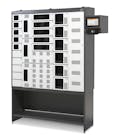Combating Internal Theft at Retail Businesses
Every retailer knows that internal losses are staggering. Depending on the source of the statistic you're quoted, internal theft can be responsible for up to 75 percent of all retail losses. Employees are responsible for so much loss that some companies are neglecting external theft concerns (such as shoplifting) in order to concentrate their loss prevention efforts almost exclusively on internal loss reduction and recovery.
Gart Sports, the company that includes Sports Authority, Sportmart and Oshman's, is an example of one retailer that focuses heavily on internal theft. Stacey Leary, the district manager of asset protection for the northeast district, which includes 25 stores in the New York City metropolitan area and Connecticut, is a seasoned industry professional who brings a "holistic" approach to this issue, combining the best in technology along with a very human ability to get dishonest employees to admit wrongdoing and to attain monetary recovery for the stolen cash or merchandise.
Technology + Interrogation = Confession
"The rubber hose is not part of my repertoire," Leary says. Instead, he relies on well-known software programs to provide him with information, then follows up with established interrogation procedures to elicit confessions and monetary recovery agreements.
Some of the software that Leary uses successfully includes programs that provide reports of employee sales, tender details, refunds, exchanges, and no sales, among other transactions. "I run reports on five 'target' or high-shrink stores in my region every day," Leary says. "Then I assign my assistants to research any transactions that are out of the ordinary."
Some of the tip-offs that cashiers may be stealing include returns that are processed without entering information from the original purchase transaction and any no-sale transactions. Once the computer red-flags a suspicious transaction, a different program allows Leary to pull up video of the cashier performing the transaction in question. Once he finds evidence of wrongdoing on the part of a specific employee, Leary will go back through and research that worker's other transactions. "Cashiers often start slow, spreading out fraudulent returns over a period of time," he says. "But then they get greedy, and that's when they get caught."
The Human Element
Leary builds a case against the employee by examining past transactions for evidence of theft, then calls the person in for an interview. He cites as an example a cashier who processed an excessive number of returns. When he looked at the surveillance video, it showed the employee processing returns when no customers were present.
"This person would crumple a receipt and slip it into a pocket," he recounts. "Then this cashier opened the cash drawer without using a key -- the worker had figured out a way to manipulate the drawer mechanically, which actually revealed a weakness that we didn't know about." The tapes then showed the employee's hands sliding under the till, where the large bills are kept, then the hands coming out balled up into fists -- crunching up hundred-dollar bills. The worker then secreted the money inside clothing.
Leary started the interview with this individual as he does with others: by letting the employees know that he or she has been totally outfoxed by the technology the store has in place. "I always explain the different investigative methods that the store uses, such as undercover employees, pinhole cameras, and records or transactions," he reveals. "Not every method is used in every case, but by demonstrating that there's no way the person could get away with the fraud, you're setting them up to confess because they perceive that there's no way out -- they're caught.
"I always tell them that I'm there to help them," he adds, "but I'm not, of course."
He then goes on to pave the way for a confession by mentioning cases of other employees who have stolen and their reasons for doing so. "I put myself in their shoes," Leary says. "I say that the thefts are understandable. I allow them to save face."
One of the things that Leary says works in his favor is that we are raised to tell the truth, and we're also taught that stealing is wrong. "I never call their actions 'stealing'," he stresses. "It's always an 'error in judgment'. Once you say the word 'stealing', the interviewee starts thinking about the consequences, and you don't want that to happen. If they think about what's going to happen to them, they won't reveal any of the other crimes they've committed against the store."
Interestingly enough, Leary says that what most employees are thinking about during the interview is whether or not they'll lose their job -- not whether they'll go to jail for what they did. "I tell them that I'm not the person who makes that decision and that they shouldn't concern themselves with that right now. And they keep talking," he says.
Tying up the Legal Ends
"You always want to get an admission of guilt," Leary says. "You don't want to have to spend any time in court, and an admission is a good way to avoid that."
The company goes after employees for civil recovery, and if the amount is large enough, it will call in the police and prosecute.
In particularly tough cases, Leary says that he will ask a suspected employee, "What would you do about an employee who's stealing if you were in my shoes?"
"If the person says, 'I'd give the employee another chance,' you know you've got him," Leary says. "No honest person will say that."
According to Leary, the key to reducing internal theft is to use both technology and interviewing skills. "You can't have just the technology or just someone on staff who can conduct an interview," he says. "You need both in order to be effective."
About the author: Liz Martinez is the author of "The Retail Manager's Guide to Crime and Loss Prevention: Protecting Your Business from Theft, Fraud and Violence" (2004, Looseleaf Law), and is a retail security/loss prevention consultant and an instructor at Interboro Institute in New York City. She can be reached through her website at www.retailmanagersguide.com.


